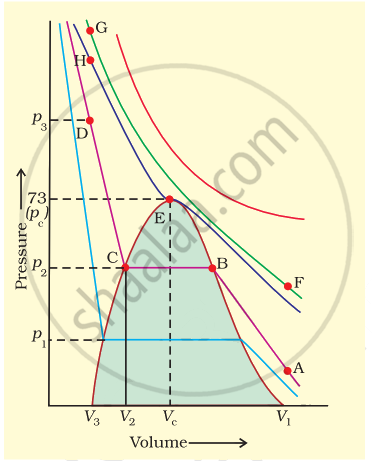Advertisements
Advertisements
Question
Write the Van der Waals equation for a real gas. Explain the correction term for pressure and volume.
Solution
Vander Waals equation for a real gas is given by
`("P" + ("an"^2)/("V"^2)) ("V" - "nb") = "nRT"`
Pressure Correction:
The pressure of a gas is directly proportional to the force created by the bombardment of molecules on the walls of the container. The speed of a molecule moving towards the wall of the container is reduced by the attractive forces exerted by its neighbours. Hence, the measured gas pressure is lower than the ideal pressure of the gas. Hence, van der Waals introduced a correction term to this effect.
Where n is the number of moles of gas and V is the volume of the container
`"p" ∝ "n"^2/"V"^2`
`"P" = "an"^2/"V"^2`
Where a is proportionality constant and depends on the nature of gas
Therefore, P = `"P" + "an"^2/"V"^2`
Volume Correction:
As every individual molecule of a gas occupies a certain volume, the actual volume is less than the volume of the container, V. Van der Waals introduced a correction factor V to this effect. Let us calculate the correction term by considering gas molecules as spheres.
V = excluded volume
Excluded volume for two molecules = `4/3` π(2r)3 = 8Vm
where Vm is a volume of a single molecule.
Excluded volume for single molecule = `(8"V"_m")/2` = 4Vm
Excluded volume for n molecule = n(4Vm) = nb
Where b is van der Waals constant which is equal to 4Vm
V’ = nb
Videal = V – nb
Replacing the corrected pressure and volume in the ideal gas equation PV = nRT we get the van der Waals equation of state for real gases as below,
`("P" + ("an"^2)/("V"^2)) ("V" - "nb") = "nRT"`
The constants a and b are van der Waals constants and their values vary with the nature of the gas.
APPEARS IN
RELATED QUESTIONS
Calculate the volume occupied by 8.8 g of CO2 at 31.1°C and 1 bar pressure. R = 0.083 bar L K–1 mol–1.
Which of the following is the correct expression for the equation of state of van der Waals gas?
Compressibility factor for CO2 at 400 K and 71.0 bar is 0.8697. The molar volume of CO2 under these conditions is
Suppose there is a tiny sticky area on the wall of a container of gas. Molecules hitting this area stick there permanently. Is the pressure greater or less than on the ordinary area of walls?
Explain whether a gas approaches ideal behavior or deviates from ideal behaviour if it is compressed to a smaller volume at a constant temperature.
Explain whether a gas approaches ideal behavior or deviates from ideal behaviour if the temperature is raised while keeping the volume constant.
Explain whether a gas approaches ideal behavior or deviates from ideal behaviour if more gas is introduced into the same volume and at the same temperature.
A plot of volume (V) versus temperature (T) for a gas at constant pressure is a straight line passing through the origin. The plots at different values of pressure are shown in Figure. Which of the following order of pressure is correct for this gas?
Assertion (A): At constant temperature, pV vs V plot for real gases is not a straight line.
Reason (R): At high pressure all gases have \[\ce{Z}\] > 1 but at intermediate pressure most gases have \[\ce{Z}\] < 1.
Isotherms of carbon dioxide gas are shown in figure. Mark a path for changing gas into liquid such that only one phase (i.e., either a gas or a liquid) exists at any time during the change. Explain how the temperature, volume and pressure should be changed to carry out the change.
